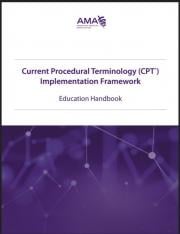Overview
Purpose of the Framework Component
This component of the education handbook outlines the overall structure. It includes an overview of the American Medical Association’s (AMA's) Current Procedural Terminology (CPT®)[1] content uses and implementation approaches, a description of the CPT implementation components of the handbook, a summary of the contents for each one, and outlines how this component is linked to others.
Intended Audiences
This portion of the education handbook is relevant to all audiences, including
- Physicians/doctors
- Physician specialist groups
- Health service delivery organizations
- Vendors
- Local/national governments
- Local/national physician/doctor associations/organizations
- National information/standards and policy organizations
Learning Objectives
After reviewing the content in the Framework Component, the reader is expected to be able to:
- Explain the uses of CPT content.
- Describe the implementation approaches.
- List all the education handbook components.
- Explain the contents of each component.
- Identify how this component links to others.
Modules
The Framework Component includes two modules.
Module One: Overview of CPT Content Uses and Implementation Approaches – An explanation of CPT content uses and implementation approaches.
Module Two: Components of the Education Handbook – A description of all the CPT implementation components of the handbook, a summary of the contents for each one, and how this component is linked to others.
Each module is structured as follows. Note that some sections may not apply to a specific mod
Introduction – An introduction to the topic being discussed and why it is important.
- Intended Audience – The intended audience for the module.
- Learning Objectives – A list of learning objectives that will be covered in the module.
Main Module Content – The main content may consist of five main sub-sections.
- Personnel – People who are involved in the topic.
- Tooling – Tooling and requirements that are required to apply the approach.
- Approach – The approach or methodology specific to a topic.
- Process – The interaction between personnel with other personnel and/or tooling.
- Challenges – Challenges associated with applying the approach.
Practical Use Example – An example of how the approach has been used.
Linkages and Dependencies
The CPT Implementation Framework Education Handbook is intended to be consumed either as a whole or split off into pieces. However, there are relationships between the components. A dependency relationship exists when one component uses or depends on another component. In addition, a dependency relationship may also represent precedence, where one component must precede another.
Module One: Overview of CPT Content Uses and Implementation Approaches
Introduction
Given the comprehensiveness of the CPT content, there is a broad range of uses. Knowing the options for CPT content use as the starting point is helpful in defining the clinical term problem, identifying the potential terminology solution, assessing the feasibility, deciding on adoption, and selecting an implementation approach. This module has three sub-sections: (1) Overview of Primary and Secondary Data Use, (2) Types of CPT Content Use, and (3) Implementation Approaches.
Intended Audiences
As noted above in the Component Overview.
Learning Objectives
After reviewing the content in this module, the reader is expected to be able to:
- Explain the types of CPT content use.
- Describe the implementation approaches.
Overview of CPT Content Uses and Implementation Approaches
Overview of Primary and Secondary Data Use
Use of health care data can be categorized into primary and secondary uses. For example, a patient entering or re-entering the health care system would see a clinician in order to receive services. At the point of care using an electronic health system, eg, EMR, EHR, HIS, or HeIS, the clinician records the services using CPT clinician descriptors. Clinician data entry at the point of care represents primary data use. The electronic health system captures and stores the CPT codes associated with the clinician descriptors in a clinical data repository. Extracts from the repository are submitted, for example, to a government-funded or private insurance administrator, as items in a data set. These extracts are used by research facilities for analysis and reporting by government agencies and private insurers to monitor the services provided by physicians/doctors, for budgeting and claims administrators to determine reimbursement, and for auditing medical services and procedures. Use of these extracts are examples of secondary data uses.
Another example representing secondary data use involves the patient accessing health information using a patient portal. Searching for health information returns information about the services and procedures provided to the patient. This is accomplished via a relationship between the CPT clinician descriptors reported by the clinician and the CPT® consumer friendly descriptors found in an electronic health system.
The next table illustrates the types of CPT content use, the typical user of the content, and whether the use is primary or secondary.
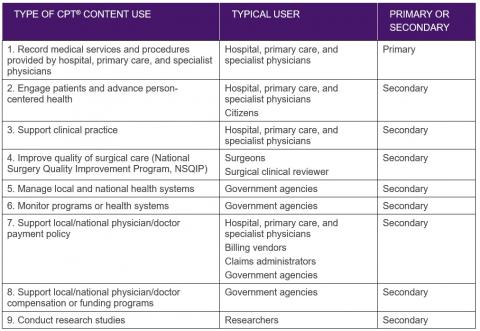
Below are the detailed descriptions of each type of CPT content use.
Record medical services and procedures provided by hospital, primary care, and specialist physicians (primary)
For this use, the purpose of the CPT content is to:
- Represent clinically relevant physician medical service and procedure terms in order to collect, view, and report data for the purpose of providing care and services and exchanging data for continuing care, eg, patient referrals
- Provide comprehensive clinical content reflecting current practice for use by all physicians
- Furnish clinical reporting policy that supports accurate data capture by the physician
The benefactor(s) of the information identified by the CPT content include:
- Hospital, primary care, and specialist physicians
- Physician/doctor medical associations/organizations
- Local/national government
- Residents
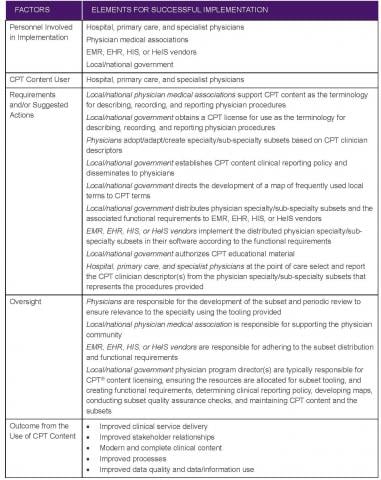
Engage patients and advance person-centered health (secondary)
For this use, the purpose of the CPT content is to provide:
- Consumer friendly descriptors that translate each CPT descriptor into language that is easily understood by the average patient and caregiver
- A strategic, innovative digital health solution supporting patient engagement and improved outcomes.
The benefactor(s) of the information identified by the CPT content include:
- Hospital, primary care, and specialist physicians
- Residents
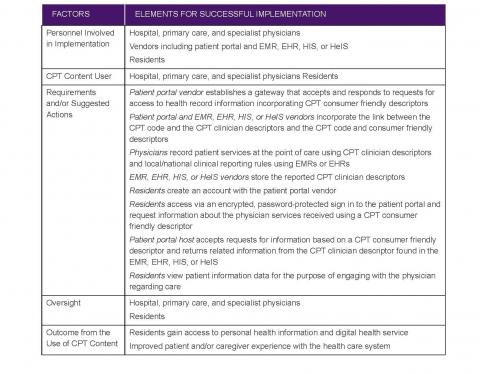
Support clinical practice (secondary)
For this use, the purpose of the CPT content is to:
- Represent clinically relevant physician medical service and procedure terms in order to:
- View past services and procedures
- Run patient queries
- Recall patients
- Provide comprehensive clinical content that reflects up-to-date and complete information about medical services and procedures provided
The benefactor(s) of the information identified by the CPT content include:
- Hospital, primary care, and specialist physicians
- Residents
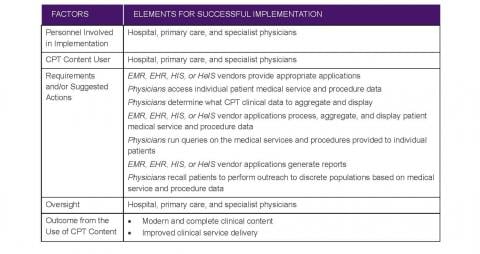
Improve quality of care (secondary)
For this use, the purpose of the CPT content is to:
- Provide a comprehensive physician-based clinical terminology for identifying surgical procedures for quality reporting
- Furnish the required ACS NSQIP® data variables of principal operative procedure, additional procedures, and re-operation CPT descriptors and codes for patients undergoing major surgical procedures in both the inpatient and outpatient setting
- Monitor patient outcomes following major surgical procedures
The benefactor(s) of the information identified by the CPT content include:
- Residents
- Hospital, primary care, and specialist physicians
- Hospitals and organizations
- Local/national government

Manage local and national health systems (secondary)
For this use, the purpose of the CPT content is to:
- Provide the crucial procedural/service component needed for the software program to determine the correct “group” to place an inpatient or outpatient discharge
- Understand case-mix complexity
- Analyze, report, and budget
The benefactor(s) of the information identified by the CPT content include:
- Hospitals
- Local/national government
- National information/standards and policy organizations
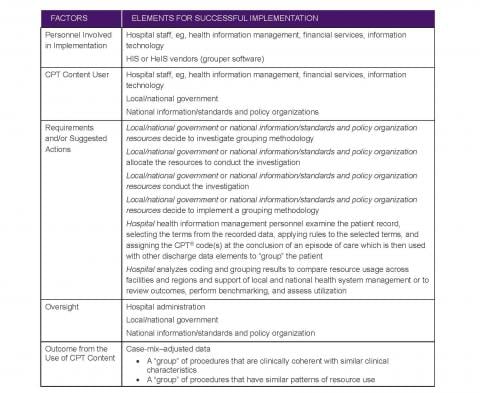
Monitor programs or health systems (secondary)
For this use, the purpose of the CPT content is to:
- Represent clinically relevant physician medical service and procedure terms
- Provide a comprehensive clinical terminology for mapping to a classification
- Perform analysis of national, population, or public health data sets
The benefactor(s) of the information identified by the CPT content include:
- National information/standards and policy organizations
- Research facilities
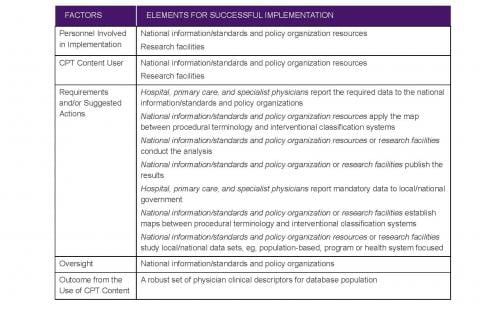
Support physician/doctor payment policy (secondary)
For this use, the purpose of the CPT content is to:
- Provide a comprehensive physician-based clinical terminology for capturing medical services and procedures that can be used for:
- Billing physician medical services and procedures
- Processing claims
- Paying physicians/doctors based on government payment policy
- Auditing physician medical services and procedures
- Facilitate clinical reporting policy that supports accurate:
- Data capture by the physician
- Billing by contracted vendors
- Technical requirements content for vendor specifications
- Auditing of claims data
- Support technical requirements content for vendor specifications
- Facilitate consistent payment policy
The benefactor(s) of the information identified by the CPT content include:
- Hospital, primary care, and specialist physicians
- Local/national government
- Residents
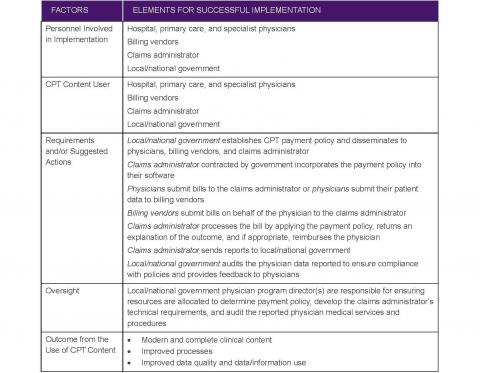
Support local/national physician/doctor compensation or funding programs (secondary)
For this use, the purpose of the CPT content is to:
- Provide a comprehensive physician-based clinical terminology with established relationships to the resource-based relative value scale (RBRVS)
- Evaluate local/national physician compensation models
- Reporting and budgeting
The benefactor(s) of the information identified by the CPT content include local/national:
- Hospital, primary care, and specialist physicians
- Physician medical associations
- Local/national government

Conduct research studies (secondary)
For this use, the purpose of the CPT content is to:
- Provide a comprehensive physician-based clinical terminology for comparison with other terminologies or classifications
- Analyze procedural terminology and interventional classification systems
The benefactor(s) of the information identified by the CPT content include:
- Local/national government
- National information/standards and policy organizations

Implementation Approaches
Implementation approaches include the following:
- Feasibility study – Overarching preliminary project research
- Pilot study – A specific type of research that tests the overall project processes
- Program specific – Project limited to a specific program
- Phased – Selection and prioritization of segments of the project
- Parallel execution – Operation of new and legacy processes simultaneously over a set period of time
- “Big bang” – All segments of the project put into practice at a single point in time
The implementation approaches are intended to:
- Increase awareness, knowledge, and buy-in of influencers, decision makers, and physicians
- Create stakeholder networks to increase support
- Demonstrate potential benefits and adoption feasibility
- Develop supports to address key implementation challenges
- Encourage adoption, implementation, and quality clinical data collection
- Corroborate terminology quality assurance and ensure integrity is sustained through adoption and implementation
- Identify and support consistent, reusable documentation, processes, and technical requirements
The following table suggests an implementation approach(es) for a specific CPT content use.
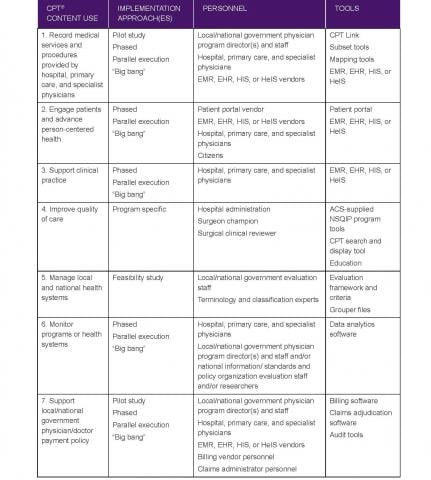
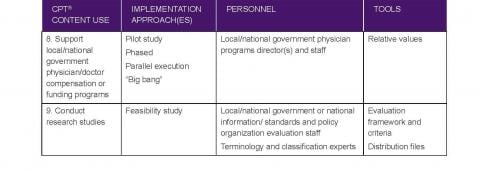
Each approach has considerations and risks. For example, how does one choose among the options to pilot test and what is the risk in selecting one over another? In addition, there may be dependencies, eg, address the record of medical services and procedures use concurrently with the support clinical practice use.
Some questions to consider when choosing the approach include:
- Feasibility study – For the problem articulated in the project profile, is the CPT content the right solution?
- Pilot study – What should be piloted to best represent the overall process(es)?
- Program specific – Which clinical areas (eg, quality improvement initiatives, a specific physician specialty such as radiology or anesthesia) are the ones for which the CPT content is the right solution for the identified problem?
- Phased – What should be phased in first, second, etc?
- Parallel – What is the period of time for simultaneous processes?
- “Big bang” – How extensive should the pre-launch testing be?
Module Two: Components of the Education Handbook
Introduction
A benefit of the CPT content is standard implementation processes that maintain the integrity of the terminology and ensure quality clinical documentation and reporting are possible. The 12 components in the CPT Implementation Framework Education Handbook summarized below describe such a process.
This module has four sub-sections: (1) Introduction to the Components, (2) Contents of the Components, (3) Linkages and Dependencies, and (4) Practical Use Example.
Intended Audiences
This portion of the education handbook is relevant to all audiences, including
- Physicians/doctors
- Physician specialist groups
- Health service delivery organization
- Vendors
- Local/national governments
- Local and national physician organizations
- National information/standards and policy organizations
Learning Objectives
After reviewing content in this module, the reader is expected to be able to:
- List all the CPT Implementation Framework Education Handbook components.
- Explain the contents of each component.
- Identify how this component links to others.
Components of the Education Handbook
Introduction to the Components
The 12 components that make up the CPT Implementation Framework Education Handbook are:
- Framework
- Current Procedural Terminology (CPT®) Primer
- Assessment of Feasibility
- Licensing
- Mapping
- Subsets
- Clinical Reporting
- CPT® Link
- Technical/Functional Requirements
- Educational Materials
- Terminology Management
- Resource-Based Relative Value Scale (RBRVS)
Contents of the Components
- Component 1: Framework - gives an overview of the CPT content uses, their implementation considerations and risks; describes the CPT content implementation components, the key blocks of work involved in each one, and how they form a cohesive unit recognizing linkages and dependencies.
- Component 2: Current Procedural Terminology (CPT®) Primer – supplies what is needed to understand CPT content, eg, what is CPT content, what are the benefits of adopting CPT content, reasons for wanting to investigate CPT content, and how does CPT content compare to other terminologies and classifications
- Component 3: Assessment of Feasibility – defines the steps to complete an assessment of feasibility to determine if CPT content is suitable for clinical service reporting
- Component 4: Licensing – AMA CPT Licensing overview information at https://cpt-international.ama-assn.org/importance-licensing-cptr-content
- Component 5: Mapping – stipulates the step-by-step mapping process to follow and tools needed to effectively map frequently used local terms to CPT terms; includes a sample map
- Component 6: Subsets – delivers a method for developing and maintaining CPT clinician descriptor physician specialty local/national subsets; includes examples of a subset and supporting technical files
- Component 7: Clinical Reporting – describes the supporting CPT content available as clinical reporting guidance
- Component 8: CPT® Link – explains the content contained within CPT® Link and how it relates to the CPT® 2021 Professional Edition (or other edition) book and describes how to query CPT® Link when it has been imported into a database
- Component 9: Technical Functional Requirements – outlines vendor (claims administrators, EMR companies, billing firms) requirements for CPT content implementation
- Component 10: Educational Materials – identifies AMA product education offerings relevant for implementation of CPT content by physicians, billing clerks, clinical data users, and how to obtain
- Component 11: Terminology Management – furnishes guidance on how CPT content management can most efficiently be done and implemented
- Component 12: Resource-Based Relative Value Scale (RBRVS) summarizes the relative value system, the role of the AMA/Specialty Society RVS Update Committee (RUC), the connection to CPT content, and describes uses of relativity measures.
Linkages and Dependencies
The Framework Component should be reviewed before beginning work toward CPT content implementation using this handbook. This component is linked to all other components as it introduces CPT content uses and implementation approaches and describes the CPT implementation components of the handbook. Thus, a dependency relationship also exists between the other components and this one.
Practical Use Example
The following is a brief description of the use of four components of this education handbook: Framework, Current Procedural Terminology (CPT®) Primer, Assessment of Feasibility, and Licensing.
A steering committee consisting of representatives from a government health department and the association/organization representing physicians/doctors in that region determined the current system for describing clinical services needed (to be) replaced. The reason being the clinical service content did not reflect current practice. In order to decide what the replacement should be, background information on various terminologies was gathered and a feasibility study launched. The goal was to demonstrate that it would be possible to replace current clinical content with new content in a way that would be acceptable to stakeholders. The feasibility approach selected was based on four dimensions– technical, organizational, improved content, and overall. As part of the assessment, licensing requirements were determined. At the conclusion of the study, feasibility was demonstrated, and CPT content was adopted as the replacement for the current system.
